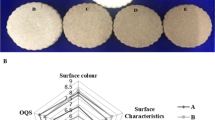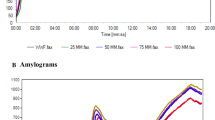Abstract
In this study, the antioxidant of canola meal protein hydrolyzed (CPH) were determined using the microbial protease enzymes alcalase and flavourzyme. Then, the effect of different concentrations of hydrolyzed protein (0, 0.5 and 1%) with carboxymethyl cellulose (CMC)-watercress seed gum composite coating, on physicochemical and sensory properties of nuggets at the beginning of storage period and chemical properties and acrylamide content were examined during a 28-day refrigeration (4 ± 1 °C) period. The results related to the properties of CPH showed that alcalase enzyme can produce a CPH with a higher degree of hydrolysis, protein content, protein recovery, antioxidant properties (P < 0.05). The best results were related to CPH by alcalase enzyme and 30 min hydrolysis time, which was used to study the properties of nuggets. The results related to the qualitative properties of nuggets showed that the addition of composite coating + CPH reduced oil absorption and increased moisture, coating pick-up, and frying efficiency (P < 0.05). All treatments were approved by sensory evaluators. Composite coating + CPH significantly delayed the oxidative spoilage process in nuggets and increased the shelf life of nuggets (P < 0.05), and with increasing concentration of CPH, better results was observed (P < 0.05), as well as, the lowest acrylamide content was observed in this treatment.



Similar content being viewed by others
References
AOAC (2005) Official Method of Analgsis, 17th edn. Association of Official Analytical chemists, Washington, DC
Aderinola T, Fagbemi. T, Monisola Alashi EV, Emmanuel Aluko A (2018) Amino acid composition and antioxidant properties of Moringa oleifera seed protein isolate and enzymatic hydrolysates. Heliyon 4(10):e00877
Alashi AM, Blanchard CL, Mailer RJ, Agboola SO, Mawson AJ, Rong H, Malomo SA, Girgih AT, Aluko RE (2014) Blood pressure lowering effects of Australian canola protein hydrolysates in spontaneously hypertensive rats. Food Res Int 55:281–287
Ali MR, Parmar A, Niedbała G, Wojciechowski T, Abou El-Yazied A, El-Gawad HGA, Nahhas NE, Ibrahim MFM, El-Mogy MM (2021) Improved shelf-life and consumer acceptance of fresh-cut and fried potato strips by an edible coating of garden cress seed mucilage. Foods. 10(7):1536
Alishahi AR, Ojagh SM, Shabanpour B, Izadi S (2017) The use of chitosan and carboxy methyl cellulose to crispness enhancement of microwave-reheated fish nugget. Iran J Food Sci Technol 14(65):139–148
Altunakar B, Sahin S, Sumnu G (2006) Effects of hydrocolloids on apparent viscosity of batters and quality of chicken nuggets. Chem Eng Commun 193:675–682
Bagheri R, Izadi Amoli R, Tabari Shahndash N, Shahosseini SR (2016) Comparing the effect of encapsulated and unencapsulated fennel extracts on the shelf life of minced common kilka (Clupeonella cultriventris caspia) and Pseudomonas aeruginosa inoculated in the mince. Food Sci Nutr 4(2):216–222
Bahrami S, Khademi D (2020) Effect of the nanoencapsulated sour tea (Hibiscus sabdariffa L.) extract with carboxymethylcellulose on quality and shelf life of chicken nugget. Food Sci Nutr 00:1–12
Campo MM, Nute GR, Hughes SI, Enser M, Wood JD, Richardson RI (2006) Flavour perception of oxidation in beef. Meat Sci 72:303–311
Chalamaiah M, Dineshkumar B, Hemalatha R, Jyothirmayi T (2012) Fish protein hydrolysates: proximate composition, amino acid composition, antioxidant activities and applications: a review. Food Chem 135:3020–3038
Chatterjee R, Day TK, Ghosh M, Dhar P (2015) Enzymatic modification of sesame seed protein, sourced from waste resource for nutraceutical application. Food Bioprod Process 94:70–81
Daraei Garmakhany A, Mirzaei HO, Maghsudlo Y, Kashani Nejad M, Jafari M (2012) Production of low fat french-fries with single and multi-layer hydrocolloid coatings. J Food Sci Technol 51:1334–1341
Das AK, Anjaneyulu ASR, Gadekar YP, Singh RP, Pragati H (2008) Effect of full-fat soy paste and textured soy granules on quality and shelf-life of goat meat nuggets in frozen storage. Meat Sci 80(3):607–614
Esmaeili M, Ariaii P, Nasiraie LR, Yousefpour. M (2020) Comparison of coating and nano-coating of chitosan- Lepidium sativum seed gum composites on quality and shelf life of beef. Food Measure. https://doi.org/10.1007/s11694-020-00643-6
FAO/WHO (1990) Energy and protein requirements. Report of joint FAO/ WHO/UNU Expert Consultation Technical Report. FAO/WHO and United Nations University, Geneva, Series No. 724
Febles C, Arias I (2001) Phytic acid level infant flour. Food. Chem. 74:437–441
Feyzi S, Varidi M, Zareb F, Varidi MJ (2015) Extraction optimization of fenugreek seed protein. Sci Food Agric 15:3165–3176
Hamzeh A, Rezaei M, Khodabandeh S et al (2019) Antiproliferative and antioxidative activities of cuttlefish (Sepia pharaonis) protein hydrolysates as affected by degree of hydrolysis. Food Measure 12:721–727
He R, Alashi A, Malomo SA, Girgih AT, Chao D, Ju X, Aluko RE (2013) Antihypertensive and free radical scavenging properties of enzymatic rapeseed protein hydrolysates. Food Chem 141(1):153–159
Izadi S, Shabanpour B, Ojagh SM, Poria M (2017) Production of low-fat fish nugget using Hydroxypropyl methylcellulose and Chitosan. J Food Sci Technol (Iran) 62(14):261–269
Javadian SR, Shahosseini SR, Ariaii P (2017) The effects of liposomal encapsulated thyme extract on the quality of fish mince and Escherichia coli O157: H7 inhibition during refrigerated storage. J Aquat Food Prod Technol 26(1):115–123
Karazhiyan H, Razavi SMA, Phillips GO (2011) Extraction optimization of a hydrocolloid extract from cress seed (Lepidium sativum) using response surface methodology. Food Hydrocolloids 25:915–920
Ketnawa S, Benjakul S, Martínez-Alvarez O et al (2016) Physical, chemical, and microbiological properties of fish tofu containing shrimp hydrolysate. Fish Sci 82:379–389
Mahdavi-Yekta M, Nouri L, Azizi MH (2019) The effects of hydrolysis condition on antioxidant activity of protein hydrolyzate from quinoa. Food Sci Nutr 7:930–936
Mazloomi-Kiyapey N, Sadeghi-Mahoonak A, Ranjbar-Nedamani E, Nourmohammadi E (2019) Production of antioxidant peptides through hydrolysis of medicinal pumpkin seed protein using pepsin enzyme and the evaluation of their functional and nutritional properties. ARYA Atheroscler 15(5):218–227
Meng Z, Wei S, Qi K, Guo Y, Yuanfa L (2018) Secondary structure of proteins on oil release in aqueous enzymatic extraction of rapeseed oil as affected hydrolysis state. Int J Food Prop 21(1):119–127
Mohammadzade. J (2015) Investigating the effect of solvent and enzymatic extraction methods on quality chracteristics of rapeseed oil and protein. J Oilseed Plants 4(1):23–32. https://www.magiran.com/paper/1576230?lang=en
Morales G, Jimenez. M, Garcia OMM, Beristain C (2014) Effect of natural extracts on the formation of acrylamide in fried potatoes, LWT, 1 edn. Food Science and Technology
Nemati M, Javadian SR, Ovissipour M, Keshavarz M (2012) A study on the properties of alosa (Alosa caspia) by-products protein hydrolysates using commercial enzymes. World Appl Sci J 18(7):950–956
Ogolla JA, Abong GO, Okoth MW, Kabira JN, Imungi JK, Karanja PN (2015) Levels of acrylamide in commercial potato crisps sold in Nairobi County, Kenya. J Food Nutr Res 3(8):495–501
Phelan M, Aherne A, FitzGerald R, O’Brien N (2009) Caseinderived bioactive peptides: biological effects, uses, safety aspects and regulatory status. Int Dairy J 19(11):643–654
Pongsawatmanit R, Ketjarut S, Choosuk P, Hanucharoenkul P (2018) Effect of carboxymethyl cellulose on properties of wheat flour-tapioca starch-based batter and fried, battered chicken product. Agric Nat Resour 52(6):562–572
Da Rocha M, Ailén A, Prentice C et al (2018) Effects of agar films incorporated with fish protein hydrolysate or clove essential oil on flounder (Paralichthys orbignyanus) fillets shelf-life. Food Hydrocolloids 81:351–363
Safari R, Shahhoseini SR, Javadian SR (2018) Antibacterial and antioxidant effects of the echinophora cinerea extract on bighead carp (Aristichthys nobilis) fillet during two storage conditions. J Aquat Casp Sea 3(2):13–24
Sah BN, P, Vasiljevic T, McKechnie O N. (2016) Antibacterial and antiproliferative peptides in synbiotic yogurt release and stability during refrigerated storage. J Dairy Sci. 99:1–10
Sayyari Z, Rabbani M, Farahmandfar R, Kenari RE, Nadoushan RM (2021) Investigation of the effect of essential oil along with nanocoatings containing gums in the development of fish fillet storage time. J Food Measur Charact 15:3539–3552
Shahosseini SR, Javadian SR, Safari R (2021b) Evaluation of antibacterial and antioxidant activities of Liza abu viscera protein hydrolysate. J Innov Food Sci Technol 30(2):123–146
Shahosseini SR, Javadian SR, Safari R (2022) Effects of molecular weights -assisted enzymatic hydrolysis on antioxidant and anticancer activities of liza abu muscle protein hydrolysates. Int J Pept Res Ther 28:72
Shahosseini SR, Safari R, Javadian SR (2021a) Evaluation antioxidant effects of Pullulan edible coating with watercress extract (Nasturtiumn officinale) on the chemical corruption of fresh beluga sturgeon fillet during storage in a refrigerator. Iran Sci Fisheries J 30(2):123–146. https://doi.org/10.22092/ISFJ.2021.124553
Shahosseini SR, Safari R, Javadian SR, Habibi F (2019) Evaluation effect of carboxymethyl cellulose coating with Anethum graveolens extract on quality of fried fillet fried fish (Anethum graveolens). J Aquat Casp Sea 4(2):37–46
Valipour K, Ariaii F, Khademi Shurmasti P, Nemati DM (2017) Effect of chitosan edible coating enriched with eucalyptus essential oil and α-tocopherol on silver carp fillets quality during refrigerated storage. J Food Saf 37: e122951
Varedesara MS, Ariaii P, Hesari J (2021) The effect of grape seed protein hydrolysate on the properties of stirred yogurt and viability of Lactobacillus casei in it. Food Sci Nutr 9:2180–2190
Wetter CR, Youngs CG (1976) A thiourea U.V assay for total glucosinolate content in rapeseed meals. J Am Oil Chem Soc 53:162–165
Yanar Y (2007) Quality changes of hot smoked catfish (Clarias gariepinus) during refrigerated storage. J Muscle Foods 18:391–400
Ye N, Hu P, Xu S, Chen M, Wang S, Hong J, Cai T (2018) Preparation and characterization of antioxidant peptides from carrot seed protein. J Food Qual 2018:1–9
Yusoff MM, Gordon MH, Niranjan K (2014) Aqueous enzyme assisted oil extraction from oilseeds and emulsion de-emulsifying methods. Trends Food Sci Tech 1–23
Zainol MK, Tan RC, Zin M, Ahmad Z, Danish-Daniel M (2020) Effectiveness of Toothpony (Gazza minuta) protein hydrolysate on reducing oil uptake upon deep-frying. Food Res 4(3):805–813
Author information
Authors and Affiliations
Corresponding author
Ethics declarations
Conflict of interest
The authors declare that they do not have any conflict of interest.
Additional information
Publisher’s note
Springer Nature remains neutral with regard to jurisdictional claims in published maps and institutional affiliations.
Rights and permissions
About this article
Cite this article
Mirzapour, Z., Ariaii, P., Safari, R. et al. Evaluation the Effect Hydrolyzed Canola Meal Protein with Composite Coating on Physicochemical and Sensory Properties of Chicken Nugget. Int J Pept Res Ther 28, 97 (2022). https://doi.org/10.1007/s10989-022-10403-3
Accepted:
Published:
DOI: https://doi.org/10.1007/s10989-022-10403-3




